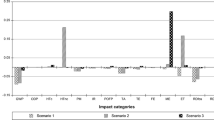Abstract.
The selection of optimal management strategies for environmental contaminants requires detailed information on the risks imposed on populations. These risks are characterized by both inter-subject variability (different individuals having different levels of risk) and by uncertainty (there is uncertainty about the risk associated with the Yth percentile of the variability distribution). In addition, there is uncertainty introduced by the inability to agree fully on the appropriate decision criteria. This paper presents a methodology for incorporating uncertainty and variability into a multi-medium, multi-pathway, multi-contaminant risk assessment, and for placing this assessment into an optimization framework to identify optimal management strategies. The framework is applied to a case study of a sludge management system proposed for North Carolina and the impact of stochasticity on selection of an optimal strategy considered. Different sets of decision criteria reflecting different ways of treating stochasticity are shown to lead to different selections of optimal management strategies.
Similar content being viewed by others
Author information
Authors and Affiliations
Rights and permissions
About this article
Cite this article
Ma, Hw. The incorporation of stochasticity in risk analysis and management: a case study. Stochastic Environmental Research and Risk Assessment 14, 195–206 (2000). https://doi.org/10.1007/PL00009781
Issue Date:
DOI: https://doi.org/10.1007/PL00009781




